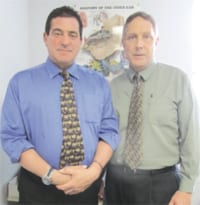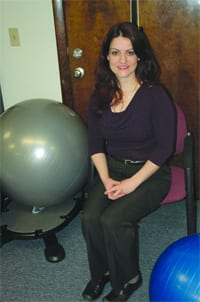Hearing Is Believing Local Specialist Patents New, ‘Invisible’ Hearing-aid Product
When Elsie Caldarola lost her ability to hear well, her life changed.
“I couldn’t hear exactly what was going on, and I felt as though I was being left out when the family discussed things. I couldn’t participate,” she told the Healthcare News.
She tried a number of custom-fitted hearing aids, “but they didn’t function well. I missed a lot of things because of background noise and echoing,” she said, referring to the sound of her own voice, which no longer sounded natural to her because the hearing aids completely blocked her ear canal.
In frustration, Elsie and her husband, Sante, appealed to their son, James Caldarola, who has owned Baystate Hearing Aids in West Springfield with Jeffrey Halls since 1989.
“She wasn’t happy, and my father told me, ‘you’re in the business … why can’t you make your mother a better hearing aid?’” he said.
So, he did exactly that. And after five years of waiting, Baystate Hearing Aids will have the patent this month for what Caldarola says is “the world’s first invisible, open-fit hearing aid.”
It is called the Micro-Air, and is suspended in the ear canal. What sets it apart from other models is that it allows natural sounds to pass through the ear canal while amplifying the frequencies that the person who wears it is missing.
Caldarola said the Micro-Air solves problems that hearing-aid specialists had struggled with for years. In fact, about 25{06cf2b9696b159f874511d23dbc893eb1ac83014175ed30550cfff22781411e5} of people who try the devices return them, he said, citing an industry figure. “In the past, we had people come back to us many times because their hearing aids needed to be modified for fit and sound or because their ear was too sensitive,” he explained, adding that background noise and echoing led to frustration.
The solution to the problem came as an epiphany one day when Caldarola was trying to determine what to do to help his mother. He moved her hearing aid partway out of her ear, and the problem instantly disappeared.
“She noticed immediately that her own voice and other sounds were normal,” said Caldarola. “I knew right away what I had to do, which was come up with something smaller that would allow air to go around the hearing aid without having it fall out.”
He developed a prototype in his lab which met those specifications by allowing natural sounds to reach the eardrum while amplifying only what was needed. The next step was to test the model on patients.
It worked well, and the new hearing aid, which is worthy of its ‘invisible’ description, is inserted far enough into the ear canal that is cannot be seen by the casual observer. “People tell me sounds are much more natural with it,” Caldarola said.
After meeting with success in initial testing, Caldarola approached Audina Labs Inc. in Florida, which agreed to become the exclusive manufacturer of the Micro-Air.
Although it is not for everyone, Caldarola has been able to fit about 50{06cf2b9696b159f874511d23dbc893eb1ac83014175ed30550cfff22781411e5} of his patients with the device, which costs less than many standard models.
During the initial fitting, the aid is attached to a personal computer, which allows the person’s hearing loss to be transferred into the unit and programmed instantly. “The settings can be changed at any time in the future,” Caldarola explained.
The Micro-Air contains state-of-the-art technology with a computer processor that automatically reduces noise and has active feedback control. “It’s an automatic system that is user-adjustable,” Halls said. It works via a button that the person wearing it can push to adjust the settings in different situations.”
Acquiring the patent has been a long, drawn-out process, said the partners.
Caldarola went to Washington, D.C. five years ago with the required paperwork, but soon discovered the U.S. Patent Office could not tell him when or if his new device might be approved. “You have to prove that your invention is not only unique, but is something remarkably new,” he said.
In the meantime, he fit hundreds of patients with the hearing aid and found that other companies began duplicating the technology.
This month the patent will belong to Baystate Hearing Aids. “I am ecstatic about this. It was a long, rocky road, and the waiting time was incredible because the patent office is very far behind. But we were thrilled in the end,” Caldarola said.
He says his patients are also happy. “There is a high satisfaction level in patients who previously rejected hearing aids. As a result, our business has really grown, and word of mouth has been tremendous,” Caldarola continued. “Everyone wants to make a difference in something, and we found the way to do it in our business with this.”
Caldarola said he’s grateful to the hundreds of patients who purchased the new hearing aid before the patent was official. “They were willing to trust our expertise in a product with new technology,” he said. “It will be interesting to see what comes next now that we have received our patent.”
But he is not worried. He and Halls have been at the forefront of their industry since they formed their company in 1989, and were numbered among the first 30 people to become board-certified and licensed in Massachusetts.
Halls handles the business end of the operation along with testing and fitting, while Caldarola is in charge of advertising, marketing, and research and development.
“It has been an interesting journey to design and implement this novel invention. And we are thrilled to be able to provide something better for the hearing impaired,” Caldarola said.
His mother is also happy.
“The new hearing aid was like night and day,” she said. “I heard things so much clearer. It gave me a whole new outlook. I felt like I was part of society again. There was no background noise, no nothing.”
Except a lot of pride and the knowledge that people with hearing loss now have an attractive cosmetic option that allows them to hear sounds like the rest of the world around them.



Comments are closed.